The AMD Ryzen Threadripper 3960X and 3970X Review: 24 and 32 Cores on 7nm
by Dr. Ian Cutress, Andrei Frumusanu & Gavin Bonshor on November 25, 2019 9:05 AM ESTGaming: Grand Theft Auto V
The highly anticipated iteration of the Grand Theft Auto franchise hit the shelves on April 14th 2015, with both AMD and NVIDIA in tow to help optimize the title. GTA doesn’t provide graphical presets, but opens up the options to users and extends the boundaries by pushing even the hardest systems to the limit using Rockstar’s Advanced Game Engine under DirectX 11. Whether the user is flying high in the mountains with long draw distances or dealing with assorted trash in the city, when cranked up to maximum it creates stunning visuals but hard work for both the CPU and the GPU.
For our test we have scripted a version of the in-game benchmark. The in-game benchmark consists of five scenarios: four short panning shots with varying lighting and weather effects, and a fifth action sequence that lasts around 90 seconds. We use only the final part of the benchmark, which combines a flight scene in a jet followed by an inner city drive-by through several intersections followed by ramming a tanker that explodes, causing other cars to explode as well. This is a mix of distance rendering followed by a detailed near-rendering action sequence, and the title thankfully spits out frame time data.
There are no presets for the graphics options on GTA, allowing the user to adjust options such as population density and distance scaling on sliders, but others such as texture/shadow/shader/water quality from Low to Very High. Other options include MSAA, soft shadows, post effects, shadow resolution and extended draw distance options. There is a handy option at the top which shows how much video memory the options are expected to consume, with obvious repercussions if a user requests more video memory than is present on the card (although there’s no obvious indication if you have a low end GPU with lots of GPU memory, like an R7 240 4GB).
All of our benchmark results can also be found in our benchmark engine, Bench.
| AnandTech | IGP | Low | Medium | High |
| Average FPS | 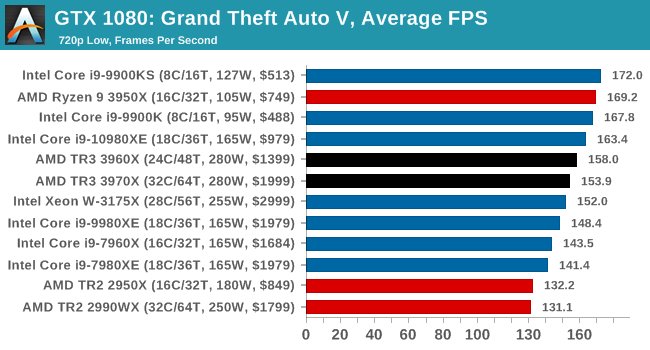 |
 |
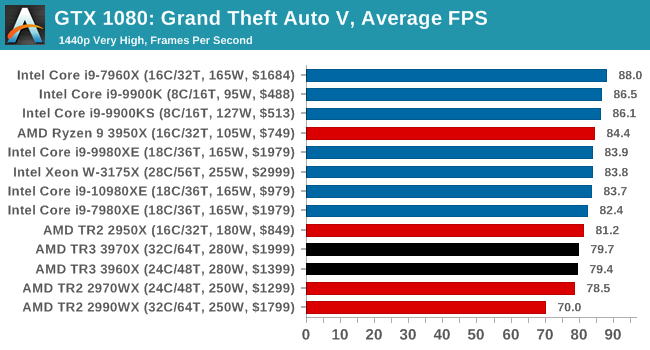 |
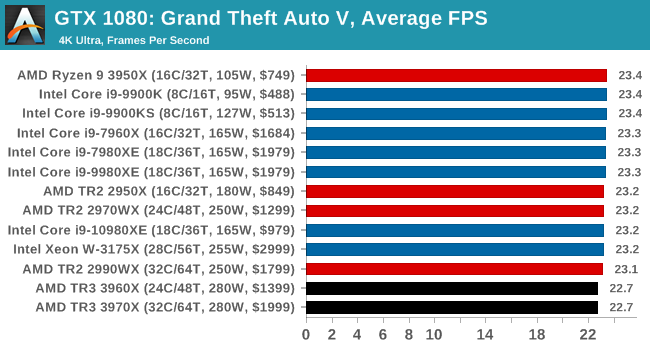 |
| 95th Percentile |  |
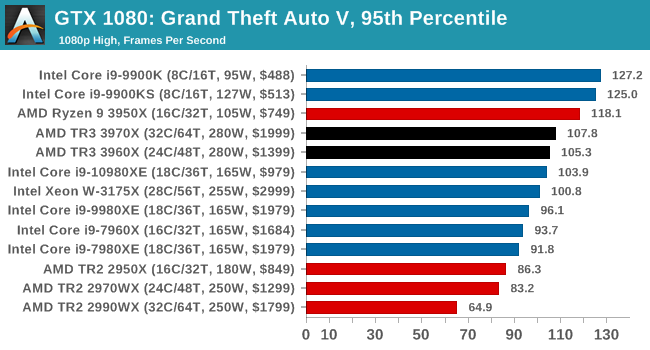 |
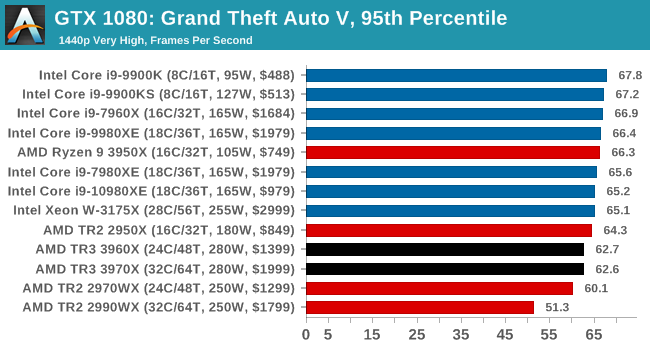 |
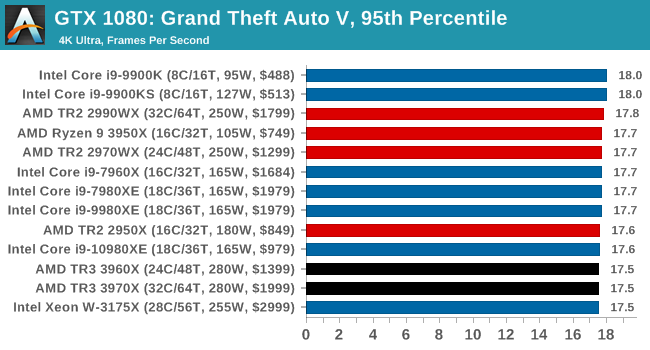 |












245 Comments
View All Comments
melgross - Tuesday, November 26, 2019 - link
What you’re missing is that I’m talking about most users. The ones you mention are in very small numbers. There’s about a billion Windows machines out there, well under 1% need 16 or more cores. That still millions, but it’s not enough to move the market.What been one of the biggest problems involving pc sales the past year? Intel not producing enough chips. Not AMD. AMD is almost an afterthought. Most vendors and customers don’t want AND. Most pc users have never even heard of and. It’s why the are cheaper, and make little profit. They sell on price. And they’re trying to move in a market Intel isn’t very interested in—yet.
Xyler94 - Tuesday, November 26, 2019 - link
Most people just need their ARM powered cell phones these days, if you really want to get down to reality. light web browsing, posting on Facebook, sending an IM on messenger, potentially watching YouTube. All things that can be done off a cellphone. For those who need a bigger display, laptops are a good choice, but see little use outside of a few instances where a bigger screen is necessary.maxxbot - Tuesday, November 26, 2019 - link
And it's a continuously moving target too, just a few years ago people would say 8 cores is way more than necessary, now it's a baseline.mdriftmeyer - Tuesday, November 26, 2019 - link
Yes they do Mel. You just don't seem to know it. When Zen 3 get AVX 512 Apple has no more need of Intel, period. Mac Pro down to Macbook Air can be replaced w/ superior low power, higher performance per watt, lower priced CPUs to match RDNA 2.0 GPGPUs.xrror - Tuesday, November 26, 2019 - link
About the too much power... it might be that nobody is saying anything because if you fully load the processor with a workload where it draws it's full 300w.......it means that it's performing a workload that a few years prior would have required 4 separate machines at full tilt to match, and I'm pretty sure that 4 older gen HEDT rigs running full tilt is going to be drawing something significantly more than 300w overall in CPU power, let alone the rest of the rigs.
Korguz - Wednesday, November 27, 2019 - link
that is not what it means....beggerking@yahoo.com - Monday, November 25, 2019 - link
you forgot virtualization. now people can run virtualized environment for casual things such as file server, media server, backups, scheduler server, and even host their own websites.Dug - Monday, November 25, 2019 - link
You forgot the cost of virtualization if using Windows. They charge per core now, not per processor.Alistair - Tuesday, November 26, 2019 - link
The cost per core is a bit problem for AMD. Company just bought 3 x Epyc servers, and the much lower price was blunted by the per core licensing. Microsoft is effectively supporting Intel unintentionally... would rather they charge based on the MSRP of the CPU or something...Alistair - Tuesday, November 26, 2019 - link
big